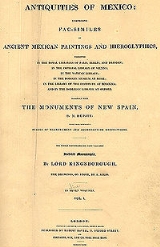
Antiquities of Mexico
Encyclopedia
Antiquities of Mexico is a compilation of facsimile reproductions of Mesoamerican literature
such as Maya codices
, Mixtec codices, and Aztec codices
as well as historical accounts and explorers' descriptions of archaeological ruins. It was assembled and published by Edward King, Lord Kingsborough, in the early decades of the 19th century. While much of the material pertains to pre-Columbian
cultures, there are also documents relevant to studies of the Spanish conquest of the Aztec Empire. Antiquities of Mexico was produced to make copies of rare manuscripts in European collections available for study by scholars.
The work consists of nine volumes, each published in a large elephant folio format. It was originally planned as ten, but Lord Kingsborough died before the full work could be completed.
Kingsborough commissioned the Italian landscape painter Agostino Aglio
to furnish the reproduction drawings and lithographs of the Mesoamerica
n artworks and codices used to illustrate the volumes. Born in Cremona
and resident in London
since 1803, Aglio had previously illustrated antiquities of Ancient Egypt
and Magna Græcia on behalf of the English architect William Wilkins
. Aglio spent the better part of six years travelling to the libraries and museums of Europe to examine and draw all of the "Ancient Mexican" documents, artefacts and manuscripts known in European collections of the time.
Many of the facsimiles of codices are hand-colored.
Mesoamerican literature
The traditions of indigenous Mesoamerican literature extend back to the oldest-attested forms of early writing in the Mesoamerican region, which date from around the mid-1st millennium BCE. Many of the pre-Columbian cultures of Mesoamerica are known to have been literate societies, who produced a...
such as Maya codices
Maya codices
Maya codices are folding books stemming from the pre-Columbian Maya civilization, written in Maya hieroglyphic script on Mesoamerican bark cloth, made from the inner bark of certain trees, the main being the wild fig tree or Amate . Paper, generally known by the Nahuatl word amatl, was named by...
, Mixtec codices, and Aztec codices
Aztec codices
Aztec codices are books written by pre-Columbian and colonial-era Aztecs. These codices provide some of the best primary sources for Aztec culture....
as well as historical accounts and explorers' descriptions of archaeological ruins. It was assembled and published by Edward King, Lord Kingsborough, in the early decades of the 19th century. While much of the material pertains to pre-Columbian
Pre-Columbian
The pre-Columbian era incorporates all period subdivisions in the history and prehistory of the Americas before the appearance of significant European influences on the American continents, spanning the time of the original settlement in the Upper Paleolithic period to European colonization during...
cultures, there are also documents relevant to studies of the Spanish conquest of the Aztec Empire. Antiquities of Mexico was produced to make copies of rare manuscripts in European collections available for study by scholars.
The work consists of nine volumes, each published in a large elephant folio format. It was originally planned as ten, but Lord Kingsborough died before the full work could be completed.
Kingsborough commissioned the Italian landscape painter Agostino Aglio
Agostino Aglio
Agostino Aglio was an Italian painter, decorator, and engraver.He was born at Cremona. He trained at the Brera academy in Milan. In 1803 he came to England to assist William Wilkins, the well-known architect, in the production of his Antiquities of Magna Graecia which was published in 1807...
to furnish the reproduction drawings and lithographs of the Mesoamerica
Mesoamerica
Mesoamerica is a region and culture area in the Americas, extending approximately from central Mexico to Belize, Guatemala, El Salvador, Honduras, Nicaragua, and Costa Rica, within which a number of pre-Columbian societies flourished before the Spanish colonization of the Americas in the 15th and...
n artworks and codices used to illustrate the volumes. Born in Cremona
Cremona
Cremona is a city and comune in northern Italy, situated in Lombardy, on the left bank of the Po River in the middle of the Pianura Padana . It is the capital of the province of Cremona and the seat of the local City and Province governments...
and resident in London
London
London is the capital city of :England and the :United Kingdom, the largest metropolitan area in the United Kingdom, and the largest urban zone in the European Union by most measures. Located on the River Thames, London has been a major settlement for two millennia, its history going back to its...
since 1803, Aglio had previously illustrated antiquities of Ancient Egypt
Ancient Egypt
Ancient Egypt was an ancient civilization of Northeastern Africa, concentrated along the lower reaches of the Nile River in what is now the modern country of Egypt. Egyptian civilization coalesced around 3150 BC with the political unification of Upper and Lower Egypt under the first pharaoh...
and Magna Græcia on behalf of the English architect William Wilkins
William Wilkins (architect)
William Wilkins RA was an English architect, classical scholar and archaeologist. He designed the National Gallery and University College in London, and buildings for several Cambridge colleges.-Life:...
. Aglio spent the better part of six years travelling to the libraries and museums of Europe to examine and draw all of the "Ancient Mexican" documents, artefacts and manuscripts known in European collections of the time.
Many of the facsimiles of codices are hand-colored.

